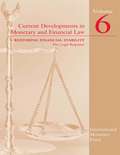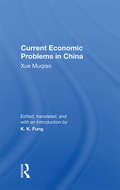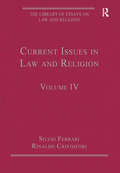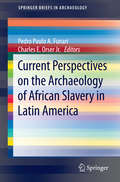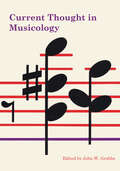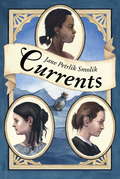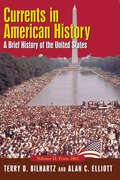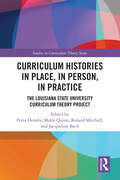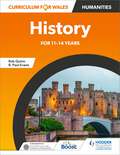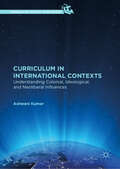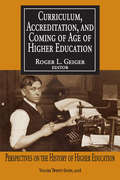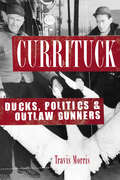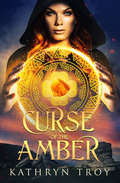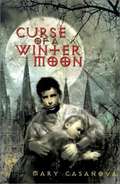- Table View
- List View
Current Developments in Monetary and Financial Law, Volume 5
by International Monetary FundA report from the International Monetary Fund.
Current Developments in Monetary and Financial Law: Restoring Financial Stability The Legal Response, Volume 6
by International Monetary FundA report from the International Monetary Fund.
Current Directions in ICT and Society: IFIP TC9 50th Anniversary Anthology (IFIP Advances in Information and Communication Technology #700)
by David Kreps Christopher LeslieThis project was motivated by the upcoming fiftieth anniversary of the IFIP Human Choice and Computers (HCC) conference, the event that led to IFIP’s Technical Committee 9 (TC 9). Although IFIP committees are mainly technical, TC 9 is dedicated to research at the intersection of information and communication technology (ICT) with society. In addition to sponsoring HCC, TC 9 supports groups that have specific research interests. In consultation with their members, the leaders of each group offer chapters about their groups’ history and goals. An additional chapter describes TC 9’s formation, and an appendix details the national groups that work closely with TC 9. Overall, this volume is a useful guide to the historical development of research on ICT and society, providing readers with important reference works and relevant themes, and also points to likely new trends in these domains.
Current Economic Problems In China
by Kwok-Kwan FungAn analysis of the PRC's current economic problems and a critical evaluation of the nation's efforts to solve them, this book brings together papers and speeches by Xue Muqiao, one of China's most prominent economists and one of its key spokesmen for liberal economic reform. Xue addresses such issues as commune and brigade enterprises; employment a
Current Issues in Law and Religion: Volume IV (The\library Of Essays On Law And Religion Ser.)
by Rinaldo Cristofori Silvio FerrariThis volume focuses on issues that have only recently come to the forefront of the discipline such as freedom from religion, ordination of homosexuals, apostasy, security and fundamentalism, issues that are linked to the common themes of secularism and globalization. Although these subjects are not new to the academic debate, they have become prominent in law and religion circles as a result of recent and rapid changes in society. The essays in this volume present multiple points of view, facilitate scholars in understanding this evolving discipline and act as a stimulus for further research.This collection gives the reader a sense of the key topics and current debates in law and religion and is of interest to law, politics, human rights, and religion scholars.
Current Issues in Women's History (Routledge Library Editions: Women's History)
by International Conference on Women's HistoryThis lively collection of essays, originally published in 1989, illustrated recent developments in the area, with chapters by contributors from many different countries and disciplines. Asking new questions and using sources in a challenging way, the contributors reflect 1980s debates about politics and academic research in women’s studies. They cover a wide range of topics, dealing for example with opportunities and obstacles for women within male-defined power-structures and institutions such as science, religious communities, and ancient Roman industry. They discuss feminists and feminist movements, analyse the utterances of women and men in medieval literature and in defamation cases, and give insights into the ways femaleness and femininity are given meaning. The essays on theory deal with such important issues as women’s historiography, and androcentrism and ethnocentrism in history.
Current Perspectives on the Archaeology of African Slavery in Latin America (SpringerBriefs in Archaeology)
by Charles E. Orser Jr. Pedro Paulo A. FunariThis edited volume aims at exploring a most relevant but somewhat neglected subject in archaeological studies, especially within Latin America: maroons and runaway settlements. Scholarship on runaways is well established and prolific in ethnology, anthropology and history, but it is still in its infancy in archaeology. A small body of archaeological literature on maroons exists for other regions, but no single volume discusses the subject in depth, including diverse eras and geographical areas within Latin American contexts. Thus, a central aim of the volume is to gather together some of the most active, Latin American maroon archaeologists in a single volume. This volume will thus become an important reference book on the subject and will also foster further archaeology research on maroon settlements. The introduction and comments by senior scholars provide a wide-ranging and comprehensive analysis of runaway archaeology that will help to indicate the global importance of this research.
Current Thought in Musicology
by John W. GrubbsCurrent Thought in Musicology covers a variety of topics, ranging from the Middle Ages to the present and touching on all the major disciplines of musicology: music history, theory and composition, music education, and performance. Taken together, the nine papers constitute a broad overview of the direction of music scholarship in the 1970s. In “Tractatus Esthetico-Semioticus: Model of the Systems of Human Communication,” Charles Seeger presents a model of the situations in which the study of humanistic art may best be conducted. Charles Hamm writes in “The Ecstatic and the Didactic: A Pattern in American Music” of the pattern of conflicting points of view in music history and theory. American composer Elliott Carter, in his chapter titled “Music and the Time Screen,” presents a lucid explanation of his compositional process, including his concept of musical time. In “Instruments and Voices in the Fifteenth-Century Chanson,” Howard Mayer Brown suggests the nature of fifteenth-century performance, drawn from iconography and various musical sources. “Nottebohm Revisited,” by Lewis Lockwood, reexamines Beethoven’s sketchbooks, showing the extent to which performing editions of his work must be updated. Daniel Heartz’s article, “The Chanson in the Humanist Era,” is multidisciplinary and will interest a variety of scholars, including French historians and French literary historians. Gilbert Chase applies structuralism to musicological studies in his chapter, “Musicology, History, and Anthropology: Current Thoughts.” The concluding essays, “The Prospects for Research in Medieval Music in the 1970’s,” by Gilbert Reaney, and “The Library of the Mind: Observations on the Relationship between Musical Scholarship and Bibliography,” by Vincent Duckles, provide a unique view of the opportunities for further work in these areas. The volume also includes an introduction by the editor, notes on the contributors, and an index. Current Thought in Musicology is the result of a symposium held at the University of Texas at Austin in 1971.
Current Thought in Musicology
by John W. GrubbsNine lectures from the 1971 symposium at the University of Texas at Austin, on music history, theory and composition, education, and performance. Ranging from the Middle Ages to the present and touching on all the major disciplines of musicology, the nine papers collected in this volume constitute a broad overview of the direction of music scholarship in the 1970s. In &“Tractatus Esthetico-Semioticus: Model of the Systems of Human Communication,&” Charles Seeger presents a model of the situations in which the study of humanistic art may best be conducted. Charles Hamm writes in &“The Ecstatic and the Didactic: A Pattern in American Music&” of the pattern of conflicting points of view in music history and theory. American composer Elliott Carter, in his chapter titled &“Music and the Time Screen,&” presents a lucid explanation of his compositional process, including his concept of musical time. In &“Instruments and Voices in the Fifteenth-Century Chanson,&” Howard Mayer Brown suggests the nature of fifteenth-century performance, drawn from iconography and various musical sources. &“Nottebohm Revisited,&” by Lewis Lockwood, reexamines Beethoven&’s sketchbooks, showing the extent to which performing editions of his work must be updated. Daniel Heartz&’s article, &“The Chanson in the Humanist Era,&” is multidisciplinary and will interest a variety of scholars, including French historians and French literary historians. Gilbert Chase applies structuralism to musicological studies in his chapter, &“Musicology, History, and Anthropology: Current Thoughts.&” The concluding essays, &“The Prospects for Research in Medieval Music in the 1970s,&” by Gilbert Reaney, and &“The Library of the Mind: Observations on the Relationship between Musical Scholarship and Bibliography,&” by Vincent Duckles, provide a unique view of the opportunities for further work in these areas. Also included is an introduction by the editor, notes on the contributors, and an index.
Currents
by Jane Petrlik SmolikThis middle-grade historical novel follows three young girls living very different lives who are connected by one bottle that makes two journeys across the ocean. It's 1854 and eleven-year-old Bones is a slave on a Virginia plantation. When she finds her name in the slave-record book, she rips it out, rolls it up, and sets it free, corked inside a bottle alongside the carved peach pit heart her long-lost father made for her. Across the Atlantic on the Isle of Wight, motherless Lady Bess Kent and her sister discover Bones's bottle half-buried on the beach. Leaving Bones's name where it began and keeping the peach pit heart for herself, Bess hides her mother's pearl-encrusted cross necklace in the bottles so her scheming stepmother, Elsie, can't sell it off like she's done with other family heirlooms. When Harry, a local stonemason's son, takes the fall for Elsie's thefts, Bess works with her seafaring friend, Chap, to help him escape. She gives the bottle to Harry and tells him to sell the cross. Back across the Atlantic in Boston, Mary Margaret Casey and her father are at the docks when Mary Margaret spies something shiny. Her father fishes it out of the water, and they use the cross to pay for a much needed doctor's visit for Mary Margaret's ailing sister. As Bess did, Mary Margaret leaves Bones's name where it belongs. An epilogue returns briefly to each girl, completing the circle of the three unexpectedly interconnected lives.
Currents in American History: A Brief History of the United States, Volume II: From 1861
by Terry D. Bilhartz Alan C. ElliottThis book focuses on the historic ramifications of a handful of essential events that shaped the American past. It describes the causes of a select number of epoch-making events and examines the short- and long-term consequences of these critical turning point moments.
Curriculum Histories in Place, in Person, in Practice: The Louisiana State University Curriculum Theory Project (Studies in Curriculum Theory Series)
by Molly Quinn Petra Hendry Roland Mitchell Jacqueline BachThis book situates the Curriculum Theory Project at Louisiana State University within a larger historical framework of curriculum work, examining the practices which have sustained this type of curricular vitality over the lifetime of the field’s existence. Divided into seven parts, the authors illuminate seven practices which have sustained the scholarship, graduate programs, mentorship, and networking that have been critical to maintaining a web of international relationships. This exploration and coming together of intergenerational stories reveals a more complete and nuanced narrative of the development of curriculum theory over the last 60 years. Crucially, the project exemplifies the continuing resilience of curriculum theory despite ongoing neo-liberal aspirations to reframe education as a business. Reflecting upon the lived experiences and articulated memories of those who have participated in the project and analysis of documents collected over its 25-year history, it considers curriculum history(ies) writ large through and from this lens of practice. As such, it opens up fresh insights for cultivating the vitality and vigor of curriculum theory more broadly on an international scale and with a view to future directions for the field. It will appeal to both new and experienced scholars working across education foundations, urban education, philosophy of education, and higher education, and researchers from across history, sociology, anthropology, ethnic studies, and gender studies.
Curriculum Studies in Turkey: A Historical Perspective (Curriculum Studies Worldwide)
by Sümer AktanThis book analyzes curriculum studies in Turkey from the perspective of three paradigms—religion, science, and ideology—since the early 19th century. Using Islam as a guiding point, Turkish curriculum theory later evolved to become the classical curriculum theory. In this book, the author presents a historical account of the long, complex, and contested evolution of the Turkish curriculum, as shaped by the intellectual and international forces of the day. This interplay is designed to inform international curriculum studies across national borders.
Curriculum for Wales: History for 11–14 years
by R. Paul Evans Rob QuinnTell the story of Wales over the last 1000 years, as you discover how Welsh history, cynefin, culture and language are connected, from the past to the present.Underpinned by the four purposes of the new Curriculum for Wales, this book empowers pupils with the knowledge and skills that they need for learning, life and work.> Design a curriculum that is unique to your school. Use the content flexibly to craft a historical education that reflects your pupils and your local area, as well as covering 'What matters' statements within the Humanities AoLE.> Follow an enquiry-based approach. Starting in early medieval times, this book establishes a strong chronological spine, with later enquiries looking at changes in Wales thematically.> Develop analytical and evaluative skills. A wide range of sources and interpretations encourage pupils to think like historians, using evidence to consider change and continuity, cause and consequence.> Put progression at the heart of the curriculum. End-of-topic Activities build towards more in-depth end-of-enquiry Review and Research tasks. All activities and tasks enable each pupil to move through their individual learning journey towards their next 'Progression step'.> Explore the rich history of Wales and the global context. Understanding events and issues in Wales and the wider world - and the development of Wales as a multicultural society - will help pupils to become ethical, informed citizens.
Curriculum for Wales: History for 11–14 years
by R. Paul Evans Rob QuinnTell the story of Wales over the last 1000 years, as you discover how Welsh history, cynefin, culture and language are connected, from the past to the present.Underpinned by the four purposes of the new Curriculum for Wales, this book empowers pupils with the knowledge and skills that they need for learning, life and work.> Design a curriculum that is unique to your school. Use the content flexibly to craft a historical education that reflects your pupils and your local area, as well as covering 'What matters' statements within the Humanities AoLE.> Follow an enquiry-based approach. Starting in early medieval times, this book establishes a strong chronological spine, with later enquiries looking at changes in Wales thematically.> Develop analytical and evaluative skills. A wide range of sources and interpretations encourage pupils to think like historians, using evidence to consider change and continuity, cause and consequence.> Put progression at the heart of the curriculum. End-of-topic Activities build towards more in-depth end-of-enquiry Review and Research tasks. All activities and tasks enable each pupil to move through their individual learning journey towards their next 'Progression step'.> Explore the rich history of Wales and the global context. Understanding events and issues in Wales and the wider world - and the development of Wales as a multicultural society - will help pupils to become ethical, informed citizens.
Curriculum in International Contexts: Understanding Colonial, Ideological, And Neoliberal Influences (Curriculum Studies Worldwide)
by Ashwani KumarThis book is an exposition of how political, cultural, historical, and economic structures and processes shape the nature and character of curriculum landscapes globally. By developing theoretical connections and providing contextual background, Kumar explores how colonialism and imperialism, state-led ideological control, and the wave of neoliberalism and capitalism insidiously impact the process of curriculum development in different parts of the world. Kumar also underscores how intellectual movements such as Marxism and postmodernism have shaped curriculum theory in varied political and economic settings. By emphasizing the connections between and among diverse cultural and political conceptualizations of curriculum, this volume contributes to the internationalization of curriculum studies discourses.
Curriculum, Accreditation and Coming of Age of Higher Education: Perspectives on the History of Higher Education (Perspectives On The History Of Higher Education Ser.)
by Roger L. GeigerThis latest volume in Roger Geiger's distinguished series on the history of higher education begins with a rare glimpse into the minds of mid-nineteenth century collegians. Timothy J. Williams mines the diaries of students at the University of North Carolina to unearth a not unexpected preoccupation with sex, but also a complex psychological context for those feelings. Marc A. VanOverbeke continues the topic in an essay shedding new light on a fundamental change ushering in the university era: the transition from high schools to college.The secularization of the curriculum is a fundamental feature of the emergence of the modern university. Katherine V. Sedgwick explores a distinctive manifestation by questioning why the curriculum of Bryn Mawr College did not refl ect the religious intentions of its Quaker founder and trustees. Secularization is examined more broadly by W. Bruce Leslie, who shows how denominational faith ceded its ascendancy to "Pan-Protestantism."Where does the record of contemporary events end and the study of history begin? A new collection of documents from World War II to the present invites Roger Geiger's refl ection on this question, as well as consideration of the most signifi cant trends of the postwar era. Educators chafi ng under current attacks on higher education may take solace or dismay from the essay "Shaping a Century of Criticism" in which Katherine Reynolds Chaddock and James M. Wallace explore H. L. Mencken's writings, which address enduring issues and debates on the meaning and means of American higher education.
Currituck: Ducks, Politics and Outlaw Gunners
by Travis MorrisIn this insider account, Currituck native Travis Morris takes readers into the blind and regales them with stories of powerful men and their guns in a bygone era when duck hunting clubs flourished and featured prominently in local politics, neighbors feuded over duck hunters rights and interloping men of industry swept in to build lodges. Senators, governors and presidents came, and these are the untold stories of their hunts.
Curse Not the King: Rebel Princess, Curse Not The King, And Far Flies The Eagle (The Romanov Trilogy #2)
by Evelyn AnthonyThe tale of the treacherous battle for the throne between Catherine the Great and her son Paul, set against the backdrop of late-eighteenth-century Russia The year is 1773. Catherine the Great has been in power for a decade. Since the assassination of her husband, Peter III, in a coup d'état, she has been empress of all the Russias. She rules with enlightenment and grace, driven by ambition and her secret dream to free Russia's millions of serfs. Tonight she is celebrating the wedding of her son Paul Petrovitch. He was nine--and the rightful heir to the throne--when Peter died and Catherine seized power. Her son has neither forgotten nor forgiven, and hatred for his mother--and his father's murderer--festers in his heart. He doesn't know that Catherine committed a terrible crime to safeguard his liberty and his life. She prays that marriage will be the solution to his violent rages and the dangerous enmity between them. Curse Not the King chronicles the struggle for dominance between mother and son. Notorious for her love affairs, Catherine ruled an empire shadowed by treachery, intrigue, and deadly betrayals. But she was never able to make peace with Paul, who would go on to become czar, finally attaining his long-awaited revenge, and whose own son Alexander would reign after him. Curse Not the King is the 2nd book in the Romanov Trilogy, but you may enjoy reading the series in any order.
Curse of Honor: A Legend of the Five Rings Novel (Legend of the Five Rings)
by David AnnandaleThe reckless pursuit of honor exposes an empire to demonic invasion, in this epic fantasy novel of duty and warfare, set in the extraordinary world of Legend of the Five Rings.Striking Dawn Castle defends the mountains between the Rokugan empire and the demon-haunted Shadowlands. When a mythical city is discovered in the forbidding peaks, Hida Haru, heir and sore disappointment to his family, seizes the opportunity to prove himself. His rash expedition ends in disaster – just one samurai returns alive, and Haru is lost. Before a power struggle can break out, Striking Dawn&’s battle-hardened commander, Ochiba, is dispatched to rescue Haru. She succeeds against supernatural horrors, but Haru is… changed. Now, mysterious deaths and ill fortune plague his family. Something evil is loose and must be stopped, at any cost.
Curse of a Winter Moon
by Mary CasanovaSix years ago, twelve-year-old Marius lost his mother during the birth of his brother, Jean-Pierre, and her dying wish was that he watch over his brother. But because Jean-Pierre was born on Christmas Eve, villagers believe he is marked with the curse of the loup garou—the werewolf. Protecting Jean-Pierre has been a never-ending struggle as townsfolk constantly eye the boy with dread and suspicion. To make matters worse, his country is swept up in a hysterical campaign to find and destroy enemies of the Church, and now the villagers have made Jean-Pierre their target. Marius must defy the ruling institutions of the time to save his brother&’s life—and his own.Winner of a 2001 Minnesota Book Award, Curse of a Winter Moon is a harrowing story of one boy&’s fierce devotion to his family as he battles against prejudice and fear.
Curse of the Amber
by Kathryn TroyAn archaeologist unearths a cursed, ancient Roman and draws the ire of an evil witch in this romantic urban fantasy from the author of A Vision in Crimson. Quintus is a dutiful son and soldier, sent to Britannia to improve his marriage prospects and ensure the Druids never rise again. Roman soldiers destroyed the last Druid stronghold in a battle of blood and fire. So, he never expects to be sacrificed to their sacred bog, trapped forever by the gods below. Two thousand years later, Asenath Hayes discovers the most well-preserved body in history. And the last thing she needs is for him to wake up. As the young archaeologist delves into Druidic rituals to grasp why Quintus was offered to a Welsh bog and then resurrected, she is forced to complete her research with the "missing" body, dodge her ex-lover and mentor with his own agenda, and keep her gorgeous new houseguest under wraps. But, smitten with her as he seems, Quintus says he wants to go home. Asenath is drawn to Quintus by the secrets they share, even if it scares her. As Asenath is pulled deeper into the mysteries of the bog, she must risk everything to keep him from hell's cold grasp as she uncovers forbidden rites, awakened deities, and an attraction that transcends the ages.
Curse of the Ancients: Curse of the Ancients (Infinity Ring #4)
by Matt de la PeñaFix the past. Save the future.What is the secret history connecting the SQ to the Ancient Maya?Book includes an all-new, full-color Hystorian's Guide - your key to unlocking the fourth episode of the action-packed Infinity Ring game.
Curse of the Blue Tattoo
by Louis A. MeyerAfter being forced to leave HMS Dolphin and Jaimy, her true love, Jacky Faber is making a new start at the elite Lawson Peabody School for Young Girls in Boston. But growing up on the streets of London and fighting pirates never prepared Jacky for her toughest battle yet: learning how to be a fine lady.Everything she does is wrong. Her embroidery is deplorable, her French is atrocious, and her table manners--disgusting! Then there's the small matter of her blue anchor tattoo. . . .Despite her best efforts, Jacky can't seem to stay out of trouble long enough to dedicate herself to being ladylike. But what fun would that be, anyway?
Curse of the Winter Moon
by Mary CasanovaThe church ruled France in 16th century. Marius must put off his apprenticeship to care for his little brother, whose birth took their mother's life, and who the villagers, backed by the Church, believe will become a "loup garou" - a werewolf.

